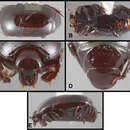Description
provided by Zookeys
Size range: Length 2.2 mm; width 1.3 mm; Body: body elongate, cylindrical, parallel-sided, rufobrunneus, ground punctation rather inconspicuous, glabrous. Head: frons rather broad, subangulate at sides in front of eyes, moderately produced in front above antennal insertions, beneath complete, subangulate frontal stria, weakly depressed at middle, with sparse ground punctures and very faint microsculpture within frontal depression; supraorbital stria weak but complete, narrowly detached from frontal stria at sides; epistoma convex, apex truncate; labrum about twice as wide as long, apex arcuate, but dorsal surface increasingly depressed to apex, making it appear somewhat emarginate; mandibles coarsely punctate on sides. Pronotum: pronotal sides subparallel in basal half, slightly arcuately narrowing to apex; marginal pronotal stria present on lateral and anterior margins, but narrowly interrupted behind eye, anterior portion continuous with lateral submarginal stria, which is complete and deeply impressed along sides; detached anterior submarginal stria transversely impressed behind head; pronotal disk with only single distinct pair of gland openings, located between anterior margin and free ends of transverse anterior submarginal stria; pronotal disk rather strongly convex, with few, small sparse secondary punctures near anterolateral corners; prescutellar impression absent. Elytra: elytral epipleuron with single epipleural stria present in basal half only, obsolete apically, outer subhumeral stria complete, inner subhumeral stria absent, dorsal striae 1-3 complete, rather crowded toward side, 4th and 5th striae absent, sutural stria thin, fragmented, obsolete in basal half; elytral disk with sparse secondary punctures in basal eighth. Prosternum: prosternal keel very shallowly emarginate at base, carinal striae complete, close together at middle, divergent anteriorly and posteriorly, free at base, united in narrow arch in front; short secondary striae present between carinal striae and procoxae; lateral prosternal striae weakly divergent; prosternal lobe very slightly deflexed, about two-thirds as long as keel, marginal stria present medially, divergent from edge, abbreviated at sides. Mesoventrite: anterior margin of mesoventrite broadly emarginate, but very weakly produced at center, marginal stria complete; mesometaventral stria coarsely crenulate, arched slightly forward onto basal third of mesoventrite. Metaventrite: postmesocoxal stria curved loosely behind coxa, extending nearly to mesepimeral-metepisternal corner; lateral metaventral stria curved laterad posteriorly toward posterior sixth of metepisternum; metaventral disk impunctate at middle, with few coarse secondary punctures at sides. Abdomen: 1st abdominal ventrite with lateral striae obliquely impressed along inner edge of metacoxa; ventrites 2-4 with few coarse punctures only at extreme sides; propygidium rather long, about two-thirds as long as broad, more or less flat, with small gland openings near anterolateral corners, disk with few small, very irregularly sparse secondary punctures; pygidium elongate, about one third longer than basal width, slightly longer than propygidium along midline, apical margin rounded, disk weakly depressed along sides, punctation similar to but finer and sparser than that of propygidium. Legs: protrochanter glabrous, meso- and metatrochanters each with two very short apical setae; femora simple; protibia with outer margin rounded, weakly 5-dentate, each tooth with moderately strong spine; posterior surface rather coarsely dimpled; protibial spurs very short; protarsus with ventral setae simple; meso- and metatibiae elongate, widened apically to about twice basal width, outer margins with 4-5 rather strong spines, mesotibia in particular faintly dentate; meso- and metatarsi short, each with single pair apicoventral spines. Male genitalia (Fig. 12): accessory sclerites present; T8 rather short, with sides subparallel, apex very deeply, narrowly emarginate, basal membrane attachment line complete distad basal emargination, ventrolateral apodemes moderately developed, well separated beneath; S8 halves approximate only at base, inner margins divergent to apex, apical guides widest near apex, with very fine inconspicuous setae; T9 with broad basal apodemes, prominent, strongly hooked ventrolateral apodemes, dorsal lobes more strongly sclerotized along sides; T10 weakly sclerotized, completely divided; S9 with sides sinuate, subparallel, apical emargination distinct, rounded, apical flange interrupted, apical corners moderately prominent; tegmen widest near middle, slightly narrowed to base, more strongly narrowed to apex, with very large medioventral process; median lobe simple, about half tegmen length; basal piece long, about two-thirds tegmen length.
- license
- cc-by-3.0
- copyright
- Michael S. Caterino, Alexey K. Tishechkin
- bibliographic citation
- Caterino M, Tishechkin A (2014) New genera and species of Neotropical Exosternini (Coleoptera, Histeridae) ZooKeys 381: 11–78
- author
- Michael S. Caterino
- author
- Alexey K. Tishechkin

